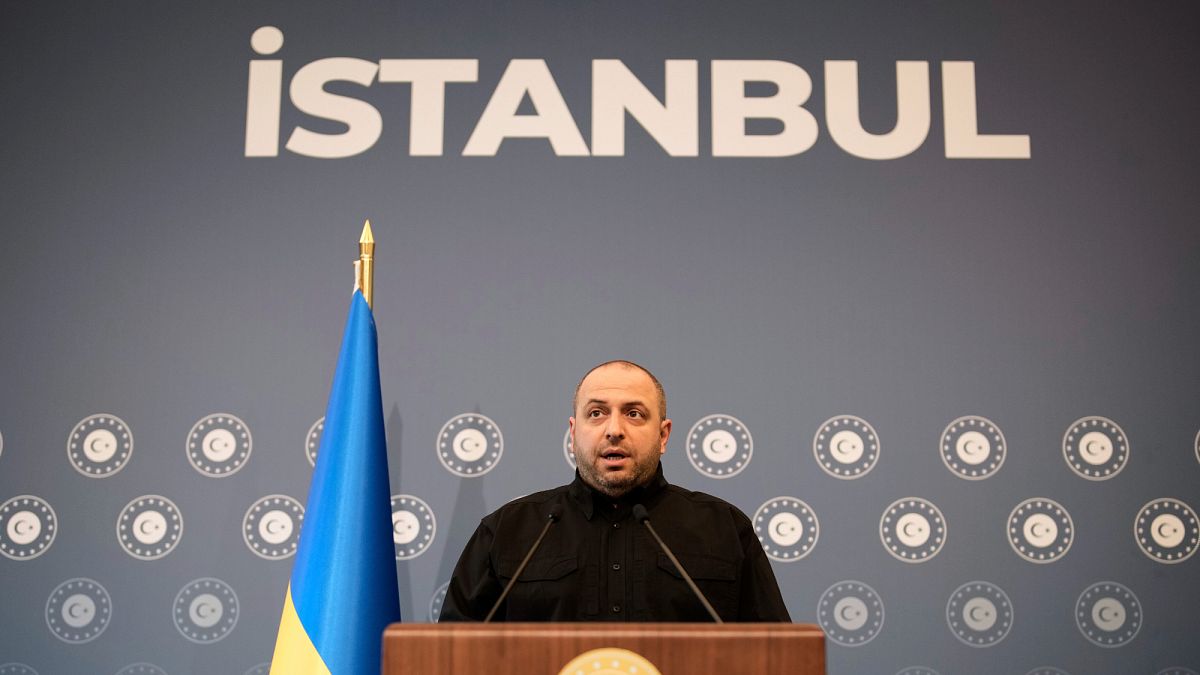Although the second round of talks between Kyiv and Moscow did not bring an end to Russia’s full-scale invasion of Ukraine any closer, it did provide more details on where both sides stand and more specifically what they are demanding from each other.
In the run up to Monday’s meeting, Kyiv and Moscow reportedly agreed to both submit their individual “peace memorandum,” outlining the key positions before delegations met for talks.
Ukraine handed its memorandum to Russia ahead of the meeting, but Russia waited until the meeting took place in Istanbul before delivering its document.
Similar to the first round on 16 May, negotiations ended with an agreement for a prisoner exchange covering two categories: young soldiers between the age of 18-25 years and seriously ill POWs.
Kyiv and Moscow also agreed to exchange the bodies of the fallen soldiers, numbering 6,000 from each side.
Russian state media reported that the heads of the delegations held a separate meeting which lasted two and a half hours – more than twice as long as the official talks – and according to Kremlin-affiliated outlets it “predetermined an efficient course of further negotiations.”
Kyiv’s peace memorandum
The key point in Ukraine’s roadmap is a ceasefire. Kyiv is demanding that be the first step towards any further measures and any possible peace deals.
The Ukrainian delegation again offered Moscow a complete ceasefire as well as a reciprocal exchange of prisoners of war, the return of children abducted by Russia and the release of all civilians from Russian captivity.
Defence Minister Rustem Umerov, who led Kyiv’s team, confirmed that Ukraine handed to Russia a list of “several hundred” Ukrainian children forcefully deported by Russia.
Another item on the agenda was organising a meeting at leadership level, possibly with US President Donald Trump in attendance.
“We believe that further work between the delegations makes sense if it is aimed at preparing a meeting between state leaders. We have proposed to the Russian side to hold a meeting at the level of leaders by the end of this month, from 20 to 30 June. This is very important for the negotiation process,” Umerov said.
According to media reports, Ukraine’s memorandum also states that Kyiv will continue on its path toward joining the EU and will become a member of NATO if there is consensus within the alliance.
Kyiv is reportedly also calling for security guarantees that would prevent Russia from launching another attack on the country, as well as the involvement of the international community to achieve this.
In return, Ukraine reportedly may be willing to accept the gradual lifting of some sanctions against Russia, but with a mechanism for their snapback renewal if necessary.
Moscow’s peace memorandum
Russia claims to have offered Ukraine a “partial” ceasefire covering certain parts of the frontline in its roadmap.
Vladimir Medinsky, the head of the Russian delegation, said Russia prepared a “two-part memorandum” the second part of which proposes a two to three-day ceasefire in certain areas during the negotiations.
He also announced the upcoming prisoner exchange and confirmed that the Russian delegation had received a list of 339 names of the children handed over by Ukraine.
Medinsky said Russia will consider each case on the list and accused Kyiv of what he called “staging a show” on the topic of the deported children, adding that it is mainly targeted at “sympathetic Europeans.”
Medinsky said Kyiv is “trying to squeeze out a tear by raising this issue.”
According to official Ukrainian information, up to 20,000 Ukrainian children remain in Russia after being illegally deported from Ukraine. These are the children for whom detailed information has been collected. Their place of residence in Ukraine and their location in Russia are known. The actual figure is likely to be much higher.
Yale’s Humanitarian Research Lab placed the number of deported Ukrainian children closer to 35,000. Moscow claimed the number could be as high as 700,000.
Regarding a complete ceasefire, Russia’s first condition is Kyiv’s “complete withdrawal of forces” from four regions of Ukraine – Donetsk, Luhansk, Zaporizhzhia and Kherson – which Moscow claims as its own annexed “new territories.”
Russia also demands international recognition of the territories it has occupied since 2014, including the Crimean Peninsula.
As per Russia’s roadmap, Western arms supplies to Ukraine should be stopped during the ceasefire and this also applies to intelligence sharing.
Moscow also demands Ukraine lift martial law and hold elections before any peace deal can be signed.
The 2 June meeting in Istanbul tool place a day after Ukraine’s operation “Spiderweb,” which say Kyiv hit over a third of all Russian missile carriers in a coordinated drone attack on Sunday.**
Following that operation, Russia’s demands to Ukraine voiced in Istanbul also include “Kyiv’s refusal to engage in sabotage and subversive activities against Russia.”

